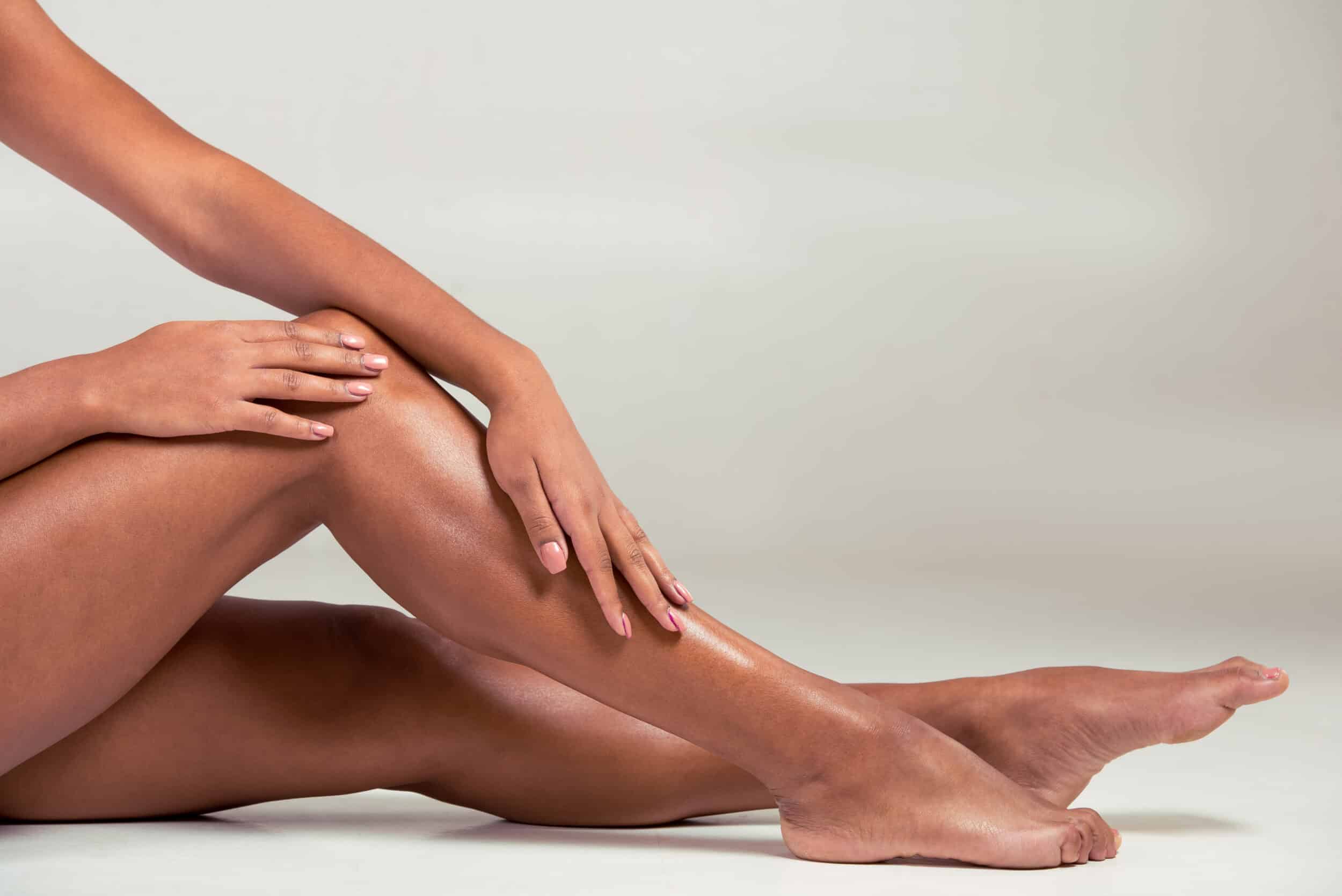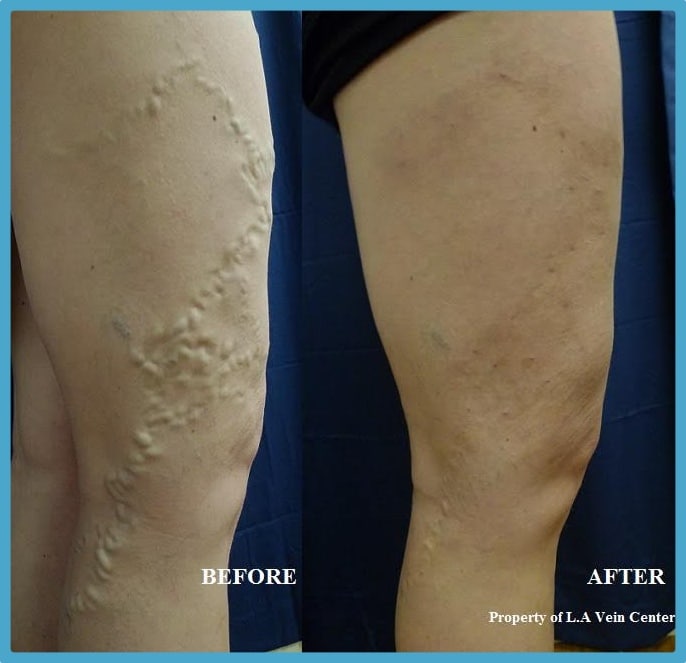
Watch How a Varicose Vein Procedure is performed above.
We Help You Resolve the Issue of Varicose Veins
Veins are the vessels that return blood to the heart once it has circulated through the body (as opposed to arteries, which carry oxygen-rich blood from the heart to the body). They have one-way valves that help keep blood flowing in the proper direction. If these valves stop functioning the way they are supposed to, blood can flow backward and pool in the vein, causing it to stretch. Our Los Angeles varicose veins doctor can help you to resolve varicose veins.
Spider Veins vs. Varicose Veins
Unlike spider veins, which are primarily superficial, varicose veins develop in deeper tissues. Varicose veins are swollen, dark blue or purple blood vessels that you can see and feel beneath the skin. The vessels that develop are larger and therefore more prominent when problems occur and form when the valves within a vein weaken and allow some blood to flow backward. The vein weakens under the additional strain and balloons outward, bulging under the skin surface. This venous disease is characterized by twisted cords of veins that bulge above the skin’s surface. Common areas in which varicose veins occur include the calves and thighs.
How Common Are Varicose Veins?
As much as 55% of American women develop varicose veins, but men may experience this problem, as well. According to research, up to 45% of men in our country struggle with some type of problematic vein issue in their lifetime. Patients with varicose veins may develop aching, throbbing, cramping, itching, ulcers and other symptoms that may indicate a need for medical attention. If you are experiencing these issues, please call L.A. Vein Center at (818) 325-0400 today.
See What Our Patients Are Saying!
"I had varicose and spider veins for a long time and they were finally causing circulation problems. My general practitioner recommended me to the L.A. Vein Center and Dr. Lee. I’m very glad he recommended me to the L.A. Vein Center. My experience was very pleasant. The staff was extremely friendly and most of all, Dr. Lee did a great job with the surgery. I would recommend this place to anyone that needs check ups concerning their veins."
*Individual results may vary
What Causes Varicose Veins?
While varicose veins can affect nearly anyone, they tend to occur more often in patients possessing certain risk factors, including:
- Older age- 50 percent of women over the age of fifty have varicose veins.
- Genetics- Approximately 50 percent of patients with report that a close family member also has this condition.
- Hormones- Fluctuating levels of progesterone and estrogen have been identified as a primary factor in the formation of varicose veins in women.
- Pregnancy- In addition to the hormonal changes during pregnancy, varicose veins may develop due to increased venous pressure from the growing uterus.
- Obesity- Excessive weight may also place excessive pressure on vessels, leading to valve weakness.
- Prolonged standing or sitting- Circulation is promoted by movement. When we sit or stand for too long, blood may more easily pool in the lower extremities.
- Lack of physical activity
Many patients bothered by their symptoms and appearance, and therefore seek treatment. Visit L.A. Vein Center to see a Los Angeles varicose veins specialist and begin your varicose vein treatment.
Varicose Veins and Blood Flow
If you notice one or more bulging veins on your legs or another area, this is an indication that valve damage has occurred to that vessel. Veins transport blood and nutrients throughout the body, and then back to the heart. Muscle contractions in the legs help to progress the upward movement of blood against gravitational forces.

To keep blood moving in the right direction, veins have one-way flaps called valves. Weakness in a valve allows blood to accumulate, causing the vein to swell.
Symptoms of Varicose Veins
The primary indicator of varicose veins is the obvious appearance of bulging vessels. Additional symptoms include:
- Restless legs
- A sensation of “heaviness”
- Swelling
- Cramping, throbbing, or aching pain that worsens with inactivity
- Itching
- Skin discoloration (in severe cases)
Generally, varicose veins do not pose a serious health threat. However, certain conditions may result from untreated venous insufficiency, including bleeding, skin ulceration, superficial blood clotting, or deep vein thrombosis, or deeper clots. Dr. Lee may examine using ultrasound in order to assess the risk for any of these concerns.
How are varicose veins diagnosed?
Your doctor can usually diagnose varicose veins after a physical examination of the affected area. Additional testing may also be performed, such as an ultrasound to evaluate the structure and blood flow within the veins.
Varicose Vein Treatment Options
While healthy weight, physical activity, and compression garments may reduce the effects of varicose veins, lifestyle modifications may not be sufficient for some people. Many people with venous disease seek treatment to reduce the symptoms and unsightly appearance of varicose or spider veins on the legs. Treatment often relieves discomfort associated with the condition such as swelling, fatigue, itching and cramps. Sometimes, however, more significant problems can develop if abnormal veins are left untreated. If venous insufficiency is left alone, it can lead to ulcers or open wounds on the legs. Left untreated, serious medical consequences may result. LA Vein Center offers comfortable solutions with a proven track record of success.
Varicose Vein Treatment Before and After Photos
LA Vein Center Offers the Following As Varicose Vein Treatment:
Sclerotherapy
Sclerotherapy may be performed with the aid of ultrasound imaging to ensure precise results that relieve the painful symptoms and the unsightly appearance of varicose veins. The affected veins are injected with a sclerosant solution, which causes the veins to eventually collapse and become absorbed into the bloodstream. Blood flow redirects to healthy veins as treated vessels close up and fade away. This safe procedure takes less than an hour.
Radiofrequency Ablation
Radiofrequency Ablation is a minimally invasive alternative to vein stripping surgery for the treatment of varicose veins and its common underlying cause, venous reflux. This advance in varicose vein treatment offers patients effective results with less pain, less bleeding and shorter recovery times than traditional procedures. The procedure involves controlled heating of vein walls using a small catheter, causing constriction and the redirection of blood flow to nearby, healthy veins. The office procedure is typically completed in less than 1 hour.
Microphlebectomy
Microphlebectomy is performed with local anesthesia and light sedation to ensure patient comfort. A special hook is used to remove the vein through multiple tiny incisions that do not usually require stitches and leave minimal scarring. This procedure can be performed for cosmetic or medical purposes, depending on each patient’s individual condition and goals for treatment. After microphlebectomy, you will be asked to wear compression stockings temporarily. The incisions typically heal within two weeks.
How Can I Prevent Varicose Veins?
While there is no surefire way to prevent varicose veins from developing, there are certain lifestyle changes that can be made in order to reduce your risk of developing this condition. This may include:
- Exercising regularly
- Maintaining a healthy weight
- Wearing compression stockings
- Elevating the legs
- Avoiding sitting or standing in one position for too long
Contact LA Vein Center today where Dr. Lee can provide you with more information as to how you can reduce your risk of varicose veins and maintain strong vascular health. You can also read more on our blog!
Varicose veins may be removed for either cosmetic or medical reasons. When medical concerns exist, many insurance companies will cover the removal procedure. We can help you resolve the appearance and discomfort. Schedule your visit to LA Vein Center at (818) 325-0400.
Post-treatment Care and Recovery
Immediate Activity: Light walking is encouraged right after treatment to promote healthy circulation and minimize complications. Most patients can resume activities within 24-48 hours.
Activity Restrictions: Avoid strenuous exercise, heavy lifting, and prolonged standing for several days. Follow specific activity guidelines provided by the medical team to ensure proper healing.

Managing Discomfort: Mild bruising, swelling, and tenderness around the treated area are common and typically resolve within a few weeks. Over-the-counter pain relievers can help.
Compression Therapy: Compression stockings support blood flow, reduce swelling, and improve healing. Wear them as directed, typically for several days or weeks, depending on the procedure.
Follow-up Appointments: Schedule follow-ups to monitor healing and confirm the success of the treatment.
Why Choose LA Vein Center for Varicose Veins
When treating varicose veins, patients trust LA Vein Center for its dedication to exceptional care and expertise. Led by Dr. Larisse Lee, a board-certified vascular and general surgeon, the center offers advanced, minimally invasive treatments designed to improve vein health. Dr. Lee’s extensive training allows her to deliver highly effective and personalized vein treatments, helping patients achieve optimal results.
Dr. Lee’s commitment to innovation and excellence is reflected in her contributions to vascular research and publications in peer-reviewed medical journals. She has earned numerous honors demonstrating her expertise and dedication to improving patient outcomes. At LA Vein Center, patients benefit from Dr. Lee’s cutting-edge knowledge and compassionate care, making the center a top choice for individuals seeking long-term relief from the discomfort and cosmetic concerns that come with varicose veins.
Frequently Asked Questions
Are varicose veins dangerous or just a cosmetic issue?
Varicose veins are often thought of as a cosmetic issue due to their appearance, but they can also be a sign of underlying venous insufficiency. In some cases, they may lead to discomfort, swelling, cramping, or heaviness in the legs. If left untreated, they can potentially cause complications such as skin ulcers, blood clots (deep vein thrombosis), or bleeding.
Are varicose vein treatments painful?
Most current varicose vein treatments are minimally invasive and cause little to no pain. Procedures like sclerotherapy, endovenous laser therapy (EVLT), and radiofrequency ablation (RFA) typically only involve minor discomfort, like slight burning or stinging during injections or insertion of the catheter. Local anesthesia or numbing agents can enhance comfort. Post-procedure soreness is usually mild and short-lived.
Can varicose veins return after treatment?
While varicose vein treatments are highly effective, there is a possibility of new veins forming over time. This can happen due to ongoing risk factors such as genetics, prolonged standing, pregnancy, or age-related vein weakening. Although treated veins typically do not return, you should maintain a healthy lifestyle and attend regular follow-up appointments to reduce the chances of recurrence.
How do I know if my varicose veins require medical treatment?
Consider medical treatment if you have any of the following symptoms:
- Persistent leg pain, heaviness, cramping
- Swelling in the legs or ankles
- Skin changes, like discoloration, thickening, or ulcers
- Burning, itching, or throbbing around the affected veins
- Recurrent bleeding or visible bulging veins
If you have a family history of venous disease or are at risk for complications, consult a vein specialist.
Book Your Los Angeles Varicose Veins Consultation at the L.A. Vein Center
Be sure to give our Sherman Oaks office a call today at (818) 325-0400 if you wish to learn more about the various treatment options we offer for Varicose Veins! Or, you can fill out the form in our contact page, and our staff will assist you with setting up your appointment. Dr. Larisse Lee looks forward to serving you!
Contact our office to learn more about our Los Angeles Varicose Vein services, or to make an appointment.


